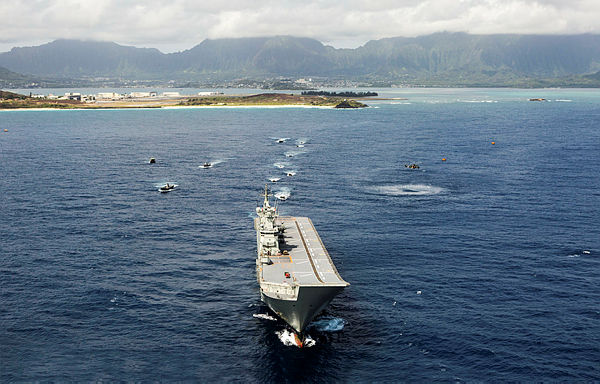They have been billed as a quantum leap for Australia’s amphibious warfare capabilities, and now the Canberra Class of Landing Helicopter Docks (LHD), particularly HMAS Adelaide, have been met with applause for stepping into a key role during the recent RIMPAC exercises in Hawaii.
Navantia was awarded the contract for the two LHDs in 2007 based on the Spanish Juan Carlos LHDs, and were designed to provide Australia with a major amphibious warfare and humanitarian response capability.
Donato Martinez, managing director of Navantia Australia, said, "The LHDs are extremely versatile ships. They can land a fully equipped force of 1,000 troops, together with their vehicles and supplies either by helicopter or landing craft, and carry out humanitarian relief operations."
The ships were constructed using the modular approach whereby the ship is divided into modules, which were built and fitted out as discrete units, before being welded together to form the completed ship. Construction of the hulls to the level of the flight deck, including the majority of fitting out, was undertaken at Navantia's Ferrol shipyard in north-west Spain. The hulls were then transported on a heavy lift ship the Williamstown shipyard in Victoria for the installation of the island structure.
The well deck is 69.3 metres long and 16.8 metres wide (1,165 square metres) and the LHD will normally carry four LCM-1Es. An additional four rigid-hulled inflatable boat (RHIBs) can be carried behind the LCM-1Es, however this will be mission dependant rather than a normal load out. The well dock has been designed to handle water craft of allied nations, including LCUs, amphibious vehicles and LCACs.
The LHD has a stern ramp/door that provides access to the well dock for landing craft and vehicles along with a fixed ramp (steel beach) between the well dock and the heavy vehicle/cargo deck (1,410 square metres). Additionally, two lateral ramp doors are located on the starboard side and provide wharf access to the heavy vehicle/cargo deck for vehicles up to 65 tonnes. Vehicular access between the heavy and light vehicle decks is achieved via a fixed ramp located on the port side.
A #RIMPAC amphibious landing demonstration yesterday from @Australian_Navy's HMAS Adelaide featured forces from Australia, Chile, Indonesia, Japan, Malaysia, New Zealand, the Philippines, South Korea, Sri Lanka, Tonga and the US @PacificMarines #CapableAdaptivePartners pic.twitter.com/bMZM2a9Mv4
— US Pacific Fleet (@USPacificFleet) 30 July 2018
The main accommodation deck is located above the well dock and heavy vehicle/cargo deck and includes crew accommodation, mess decks, medical spaces, galley facilities, office spaces, and recreation rooms. Accommodation is provided for 1,400 personnel; approximately 400 ship’s company including the watercraft and flight deck crews and 1,000 embarked force personnel including the PCRF, embarked flight, HQ staff and landing force.
These combined facilities provide the Canberra Class with their formidable amphibious capabilities, which were recently displayed during amphibious exercises that saw HMAS Adelaide embark Australian, US Marines and other multinational amphibious forces at RIMPAC.
Navantia Australia chairman Warren King remarked that the Canberra Class LHDs are one of the most capable and sophisticated air-land-sea deployment platforms in the world.
"Navantia is enormously proud of how well these remarkable ships have been performing for Australia. It comes as no surprise that they are impressing other navies with their capability. They are part of an international class of ship which are also in service with the Spanish Navy and soon, the Turkish Navy," King said.
Additionally, the flight deck has been configured with six spots on the port side for medium-sized aircraft, such as the MRH-90 Taipan or Blackhawks, which allows for simultaneous take off and landing operations; alternatively it can support simultaneous take off and landing operations of four CH-47 Chinooks.
Two aircraft elevators that can accommodate medium-sized helicopters, with one able to accommodate larger helicopters such as CH-47. Both aircraft elevators service the hangar and light vehicle/cargo deck and the forward elevator is dual rolled for stores and personnel. The vessel's hangar can accommodate up to eight medium-sized helicopters, with 18 medium-sized helicopters able to be accommodated if the light vehicle deck is also used.
The LHD has been designed with the shallowest possible draft to allow it to operate in secondary ports and harbours as well as manoeuvre tactically in the shallow waters common in the littoral regions.
Martinez said, "Whilst the Australian forces operate a fleet of helicopters from the LHDs, they call also support a range of advanced aircraft. The LHD platform offers design flexibility to meet future capability requirements, which can help Australia to meet future capability requirements."
Minister for Defence Marise Payne highlighted the performance of Australian forces at RIMPAC saying, "RIMPAC helps to sustain the co-operative relationships that are critical to maintaining international maritime security and ensuring we’re ready to work together should the time come. Over these past weeks, the ADF has proven not only its reputation as a professional military force, but also as a responsible member of a multi-national team, committed to maintaining security in the Pacific Rim."








